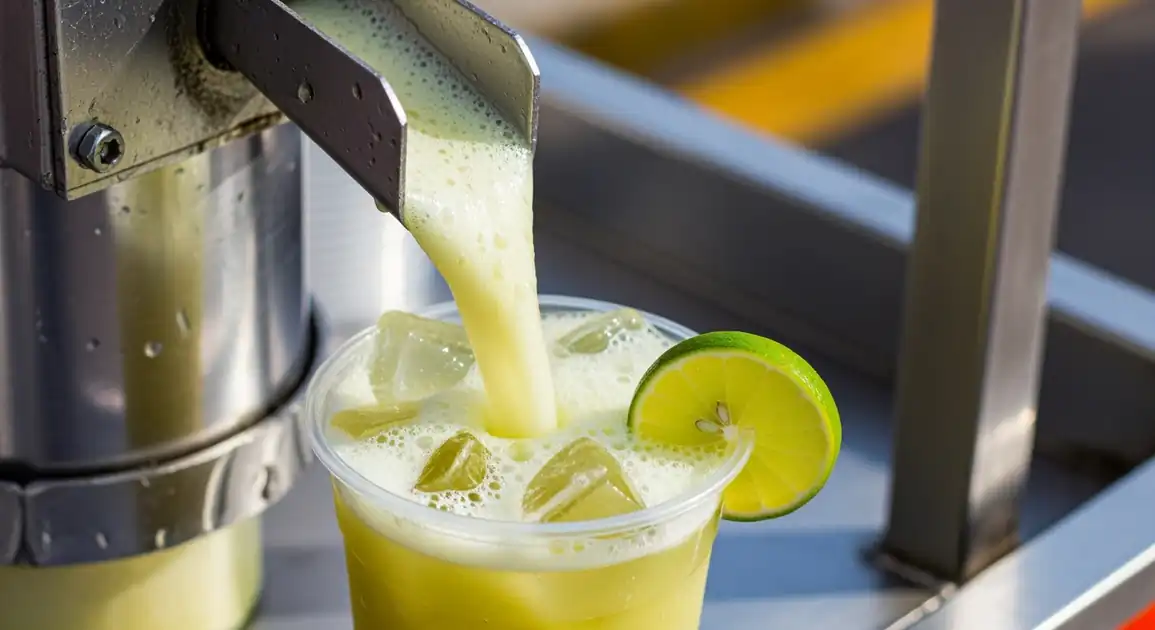Caldo de Cana com Limão (Sugarcane Juice with Lime)
Caldo de Cana com Limão

Description
In São Paulo, Caldo de Cana is a beloved fixture, especially inseparable from the vibrant culture of the city's numerous weekly street markets ('feiras livres'). You'll find vendors with their characteristic presses alongside stalls selling the equally iconic 'pastel'.
Dietary Information
Serving information
Serving style
Served in plastic cups, usually 300ml or 500ml. Drunk immediately after pressing. The combination with a hot, savory pastel is classic São Paulo feira food.
Quick facts
Feira livre vendors: approx. 7 AM - 1 PM/2 PM. Park/street vendors: Variable daytime hours, often longer on weekends.
Safety Tips
What to Look For
-
Visibly clean pressing machine (rollers, spout, tray).
Residue buildup can harbor bacteria. Ensure the parts contacting the juice look well-maintained and recently cleaned.
-
Fresh, moist-looking sugarcane stalks.
Dry or old cane yields less juice and may indicate lower quality standards.
-
Vendor using clean practices (hand washing, clean cloths).
Good hygiene prevents cross-contamination when handling cane, lime, cups, and money.
-
Use of seemingly clean water for rinsing (if observed).
Dirty rinse water can contaminate cups or the machine.
-
Clear ice, preferably from bagged/filtered source.
Avoid cloudy block ice if possible, as its water source might be questionable. Ordering 'sem gelo' (no ice) bypasses this risk.
-
High customer traffic.
Indicates the juice is pressed frequently and ingredients are likely fresh.
What to avoid
-
Dirty machine with visible grime, residue, or insects.
Major hygiene red flag. Do not buy from such vendors.
-
Dry, brown, or moldy sugarcane stalks.
Indicates old or improperly stored cane.
-
Vendor with poor personal hygiene or handling practices.
Increases risk of contamination.
-
Use of cloudy ice blocks or visibly dirty water.
Potential source of waterborne contaminants. Best to avoid ice in these cases.
-
Juice that looks unusually dark brown or smells fermented.
Fresh sugarcane juice is light greenish-yellow. Darkening or fermented smell indicates spoilage.
Price information
Price range
Budget tips
- Feira livre prices are generally the most competitive.
- Prices might be slightly higher in upscale neighborhoods or tourist spots like Mercado Municipal.
- Usually cheaper than bottled soft drinks or elaborate fruit juices.
Value indicators
- Frothy texture indicating freshness.
- Bright greenish-yellow color.
- Strong lime flavor if ordered 'com limão'.
- Vendor maintains a clean machine throughout the busy feira.
Where to Find This Dish
Neighborhood Feiras Livres
Almost every neighborhood has its designated market days/locations (e.g., Vila Madalena, Pinheiros, Jardins, Moema, Liberdade). Check online for schedules.
Specific streets designated for feiras on certain days
Market mornings (typically 7 AM - 1 PM, Tue-Sun)
Mercado Municipal de São Paulo ('Mercadão')
While famous for other foods, you can find juice stalls including Caldo de Cana inside or around the market.
Rua da Cantareira, Centro Histórico
Market hours (approx. 6 AM - 6 PM, check specifics)
Parque Ibirapuera / Other Parks
Vendors often position themselves near park entrances or along pathways, especially on weekends.
Ibirapuera Park entrances, Villa-Lobos Park
Weekend daytime
Vendor Tips
- Pair it with a freshly fried pastel for the full 'feira' experience.
- Be prepared for queues, especially at popular feiras.
- Have small change or use Pix (common digital payment).
- If trying pineapple or ginger versions, confirm they use fresh fruit.
How to Order
Regional Variations
-
Feira-Specific Additions
(Adições Específicas da Feira)
While lime, pineapple, and ginger are common, some vendors at feiras might occasionally experiment with other fruit additions like passion fruit ('maracujá'), though less traditional.
Cultural context
History
Sugarcane has been a major crop in Brazil since colonial times. The simple method of extracting juice by pressing the stalks likely emerged early on. Caldo de Cana became a popular and affordable drink for hydration and energy, especially for workers. Its presence grew with urbanization, becoming a staple at street markets ('feiras') and roadside stalls, often famously paired with 'pastel' (fried pastry).
Local significance
In São Paulo, Caldo de Cana is intrinsically linked to the social and culinary experience of the 'feira livre'. It's a symbol of simple pleasures and weekly routines.
Eating customs
- Usually consumed standing up near the stall.
- Often finished quickly before moving on.
- Juggling a cup of caldo de cana and a large pastel is a common sight.